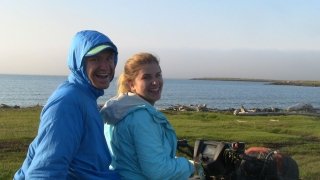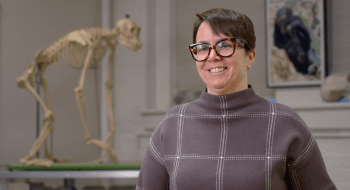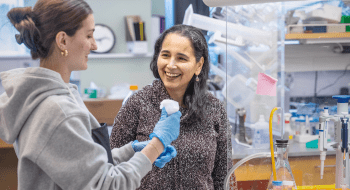
St. Lawrence Receives NSF Grants for Research Projects
The National Science Foundation has awarded two separate grants for projects led by St. Lawrence University faculty.
Alexander Stewart, associate professor of geology, received $39,607 in additional NSF support to fund his project, titled “Collaborative Research: Identifying basin-specific controls on isotopic and chronological offsets of lake sediment leaf wax hydrogen isotope records.” Funding will support student stipends, travel and equipment.
Stewart, who will work with colleagues from the University of Cincinnati, proposed to study leaf waxes preserved in lake sediments as a way to determine past precipitation in order to better understand future changes in precipitation. Leaf waxes offer the possibility of providing information about how precipitation and the water cycle have changed over time. The measure is in the changes of hydrogen isotope values. Stewart's study is meant to help define hydrogen isotope values and identify the factors that control them in order to provide improved reconstructions of past hydrological conditions.
“This research will promote a broader public understanding of the geosciences and appreciation of scientific research by expanding on museum exhibits in collaboration with the Cincinnati Museum Center,” Stewart said. “It will also improve STEM field retention by providing research and training experiences for undergraduate students to develop advanced research skill sets, expand scientific understanding, and strengthen preparation for graduate studies or a career in the geosciences.”
Stewart’s project will begin in the Fall 2016 semester.
Jon Rosales, associate professor of environmental studies, and Jessica Chapman, associate professor of statistics, were awarded $90,366 for their project, titled “Reducing Scientific Uncertainty of Storm Trends in Savoonga and Shaktoolik, Alaska with Traditional Knowledge.”
Chapman is also the principal investigator of St. Lawrence’s current “Liberal Arts Science (LAS) Scholars” NSF-funded program, which provides scholarships, faculty mentoring, and academic support to academically talented students from economically disadvantaged backgrounds who are studying in STEM fields.
Rosales and his co-collaborators at the University of Alaska Fairbanks will conduct a two-year research study in remote Alaskan villages, including two located on St. Lawrence Island in the Bering Sea, where local indigenous populations possess traditional ecological knowledge about climate changes in their region. Chapman will conduct a statistical analysis of the data that is collected by the research team.
While scientific literature indicates that climate change has likely increased the intensity of storms in the north Pacific since the 1950s, there is no direct evidence yet of the local claims.
“Villagers claim that storms are now stronger and more dangerous than previous decades,” Rosales said. “If successful, this project will verify a widely-held claim by traditional and local knowledge holders in Savoonga and Shaktoolik that storm intensity is increasing, which could be used by government authorities working on climate change adaptation plans.”
In the Siberian Yupik tradition of these villages, babies are named after storms to remember those events. Rosales will generate a storm map by combining birthdates with an analysis of driftwood accumulations in order to substantiate claims by villagers that storms have, in fact, intensified over recent decades.
Rosales took two students – Margaret Mauch ’17 of Massena, New York and Gunnar Ohlson ’17 of Frisco, Colorado – to these villages over the summer to meet with village elders and learn more about meaning of the names and if they do, in fact, relate to storm events. He will take another student to Alaska continue the project in the summer of 2017.



